#devops infrastructure management automation tools
Explore tagged Tumblr posts
Link
Robotic process automation (RPA) has revolutionized the healthcare industry, streamlining and automating routine tasks. Nolij Consulting, a leading provider of RPA services, helps healthcare organizations leverage RPA to increase efficiency, reduce costs, and improve patient care. Discover how RPA can transform your healthcare organization today.
#software test automation solutions in usa#robotic process automation service providers#automation testing tools in software testing#devops infrastructure management automation tools
0 notes
Text
Cloud Automation is crucial for optimizing IT operations in multi-cloud environments. Tools such as Ansible, Terraform, Kubernetes, and AWS CloudFormation enable businesses to streamline workflows, automate repetitive tasks, and enhance infrastructure management. These solutions provide efficiency and scalability, making them indispensable for modern cloud management.
#cloud automation tools#IT operations#seamless IT automation#Ansible#Terraform#AWS CloudFormation#Kubernetes#multi-cloud management#cloud provisioning#infrastructure automation#DevOps tools#cloud migration
0 notes
Text
Discover how Software Configuration Management Tools and Infrastructure as Code (IaC) DevOps tools can transform your tech workflow. Join us as we delve into their benefits and hear from Impressico Business Solutions on enhancing efficiency and scalability. Tune in for insights and practical tips!
#Software Configuration Management Tools#Configuration Management Tools#Infrastructure as Code DevOps Tools#DevOps Automation Tools
0 notes
Text
Optimizing Operations with Network Automation: Best Practices and Solutions

Network Automation is a game-changer in the realm of IT operations, offering a plethora of benefits for optimizing network management tasks. To harness its full potential, organizations must adopt best practices and implement effective solutions. In this blog post, we will explore some key best practices and solutions for optimizing operations with Network Automation.
Automating Routine Tasks
The cornerstone of Network Automation lies in automating routine tasks such as configuration changes, device provisioning, and network monitoring.
By automating these repetitive tasks, organizations can streamline operations, reduce manual errors, and improve overall efficiency.
Utilizing Orchestration Tools
Orchestration tools play a crucial role in managing and coordinating automated processes within the network.
Network Automation tools provide a centralized platform for designing, executing, and monitoring automation workflows, ensuring seamless integration and efficient operation.
Implementing Self-Healing Mechanisms
Self-healing mechanisms leverage Network Automation to detect and remediate network issues automatically.
By implementing proactive monitoring and alerting systems coupled with automated remediation scripts, organizations can minimize downtime and improve network reliability.
Integrating with Monitoring and Analytics
Integrating Network Automation with monitoring and analytics tools enhances visibility and insight into network performance.
By collecting and analyzing real-time data, organizations can identify trends, predict potential issues, and proactively optimize network resources.
Standardizing Configuration Management
Standardizing configuration management practices is essential for maintaining consistency and compliance across the network infrastructure.
Network Automation enables organizations to enforce standardized configurations, ensure adherence to security policies, and streamline auditing and compliance processes.
Implementing Change Management Processes
Implementing robust change management processes is critical for managing network changes effectively.
Network Automation can facilitate change management by automating change requests, approvals, and deployment processes, ensuring minimal disruption and maximum efficiency.
Get More Insights On This Topic: Network Automation
#Network Automation#IT Automation#DevOps#Network Management#Automation Tools#Software Defined Networking#Infrastructure Automation#Cloud Computing
0 notes
Text
DevOps Development Services | Hire DevOps Developer Team
At Connect Infosoft, our DevOps development services are crafted to optimize your software delivery process. Our seasoned experts collaborate with you to evaluate your existing infrastructure, development methodologies, and business objectives. We then tailor our approach to implement the most effective DevOps strategies for your organization.

From establishing efficient continuous integration and delivery (CI/CD) pipelines to automating deployment processes, we ensure your workflows are streamlined for speed and reliability. We also provide ongoing support and training to facilitate the adoption and sustenance of DevOps practices across your teams.
Partnering with Connect Infosoft for your DevOps development requirements empowers you to expedite software delivery, enhance application quality, and foster collaboration between your development and operations teams. Reach out to us today to explore how our DevOps development services can elevate your business.
#DevOps development solutions#DevOps consulting services#DevOps implementation experts#Agile DevOps methodologies#Continuous integration and delivery#DevOps automation tools#DevOps best practices#DevOps security services#DevOps infrastructure management#DevOps support and maintenance
0 notes
Text
How-To IT
Topic: Core areas of IT
1. Hardware
• Computers (Desktops, Laptops, Workstations)
• Servers and Data Centers
• Networking Devices (Routers, Switches, Modems)
• Storage Devices (HDDs, SSDs, NAS)
• Peripheral Devices (Printers, Scanners, Monitors)
2. Software
• Operating Systems (Windows, Linux, macOS)
• Application Software (Office Suites, ERP, CRM)
• Development Software (IDEs, Code Libraries, APIs)
• Middleware (Integration Tools)
• Security Software (Antivirus, Firewalls, SIEM)
3. Networking and Telecommunications
• LAN/WAN Infrastructure
• Wireless Networking (Wi-Fi, 5G)
• VPNs (Virtual Private Networks)
• Communication Systems (VoIP, Email Servers)
• Internet Services
4. Data Management
• Databases (SQL, NoSQL)
• Data Warehousing
• Big Data Technologies (Hadoop, Spark)
• Backup and Recovery Systems
• Data Integration Tools
5. Cybersecurity
• Network Security
• Endpoint Protection
• Identity and Access Management (IAM)
• Threat Detection and Incident Response
• Encryption and Data Privacy
6. Software Development
• Front-End Development (UI/UX Design)
• Back-End Development
• DevOps and CI/CD Pipelines
• Mobile App Development
• Cloud-Native Development
7. Cloud Computing
• Infrastructure as a Service (IaaS)
• Platform as a Service (PaaS)
• Software as a Service (SaaS)
• Serverless Computing
• Cloud Storage and Management
8. IT Support and Services
• Help Desk Support
• IT Service Management (ITSM)
• System Administration
• Hardware and Software Troubleshooting
• End-User Training
9. Artificial Intelligence and Machine Learning
• AI Algorithms and Frameworks
• Natural Language Processing (NLP)
• Computer Vision
• Robotics
• Predictive Analytics
10. Business Intelligence and Analytics
• Reporting Tools (Tableau, Power BI)
• Data Visualization
• Business Analytics Platforms
• Predictive Modeling
11. Internet of Things (IoT)
• IoT Devices and Sensors
• IoT Platforms
• Edge Computing
• Smart Systems (Homes, Cities, Vehicles)
12. Enterprise Systems
• Enterprise Resource Planning (ERP)
• Customer Relationship Management (CRM)
• Human Resource Management Systems (HRMS)
• Supply Chain Management Systems
13. IT Governance and Compliance
• ITIL (Information Technology Infrastructure Library)
• COBIT (Control Objectives for Information Technologies)
• ISO/IEC Standards
• Regulatory Compliance (GDPR, HIPAA, SOX)
14. Emerging Technologies
• Blockchain
• Quantum Computing
• Augmented Reality (AR) and Virtual Reality (VR)
• 3D Printing
• Digital Twins
15. IT Project Management
• Agile, Scrum, and Kanban
• Waterfall Methodology
• Resource Allocation
• Risk Management
16. IT Infrastructure
• Data Centers
• Virtualization (VMware, Hyper-V)
• Disaster Recovery Planning
• Load Balancing
17. IT Education and Certifications
• Vendor Certifications (Microsoft, Cisco, AWS)
• Training and Development Programs
• Online Learning Platforms
18. IT Operations and Monitoring
• Performance Monitoring (APM, Network Monitoring)
• IT Asset Management
• Event and Incident Management
19. Software Testing
• Manual Testing: Human testers evaluate software by executing test cases without using automation tools.
• Automated Testing: Use of testing tools (e.g., Selenium, JUnit) to run automated scripts and check software behavior.
• Functional Testing: Validating that the software performs its intended functions.
• Non-Functional Testing: Assessing non-functional aspects such as performance, usability, and security.
• Unit Testing: Testing individual components or units of code for correctness.
• Integration Testing: Ensuring that different modules or systems work together as expected.
• System Testing: Verifying the complete software system’s behavior against requirements.
• Acceptance Testing: Conducting tests to confirm that the software meets business requirements (including UAT - User Acceptance Testing).
• Regression Testing: Ensuring that new changes or features do not negatively affect existing functionalities.
• Performance Testing: Testing software performance under various conditions (load, stress, scalability).
• Security Testing: Identifying vulnerabilities and assessing the software’s ability to protect data.
• Compatibility Testing: Ensuring the software works on different operating systems, browsers, or devices.
• Continuous Testing: Integrating testing into the development lifecycle to provide quick feedback and minimize bugs.
• Test Automation Frameworks: Tools and structures used to automate testing processes (e.g., TestNG, Appium).
19. VoIP (Voice over IP)
VoIP Protocols & Standards
• SIP (Session Initiation Protocol)
• H.323
• RTP (Real-Time Transport Protocol)
• MGCP (Media Gateway Control Protocol)
VoIP Hardware
• IP Phones (Desk Phones, Mobile Clients)
• VoIP Gateways
• Analog Telephone Adapters (ATAs)
• VoIP Servers
• Network Switches/ Routers for VoIP
VoIP Software
• Softphones (e.g., Zoiper, X-Lite)
• PBX (Private Branch Exchange) Systems
• VoIP Management Software
• Call Center Solutions (e.g., Asterisk, 3CX)
VoIP Network Infrastructure
• Quality of Service (QoS) Configuration
• VPNs (Virtual Private Networks) for VoIP
• VoIP Traffic Shaping & Bandwidth Management
• Firewall and Security Configurations for VoIP
• Network Monitoring & Optimization Tools
VoIP Security
• Encryption (SRTP, TLS)
• Authentication and Authorization
• Firewall & Intrusion Detection Systems
• VoIP Fraud DetectionVoIP Providers
• Hosted VoIP Services (e.g., RingCentral, Vonage)
• SIP Trunking Providers
• PBX Hosting & Managed Services
VoIP Quality and Testing
• Call Quality Monitoring
• Latency, Jitter, and Packet Loss Testing
• VoIP Performance Metrics and Reporting Tools
• User Acceptance Testing (UAT) for VoIP Systems
Integration with Other Systems
• CRM Integration (e.g., Salesforce with VoIP)
• Unified Communications (UC) Solutions
• Contact Center Integration
• Email, Chat, and Video Communication Integration
2 notes
·
View notes
Text
The DevOps Lifecycle: Building, Testing, and Deploying with Confidence
DevOps, a combination of "Development" and "Operations," has emerged as a game-changer in the software development landscape. It represents a comprehensive approach that fosters collaboration between development and operations teams, emphasizes automation, and cultivates a culture of continuous improvement. In this blog post, we will delve deeper into the world of DevOps, exploring its principles, practices, and how it works.

The Essence of DevOps:
DevOps is more than just a buzzword; it's a mindset that aims to break down silos and bridge the gap between traditionally isolated development and operations teams. At its core, DevOps promotes collaboration, automation, and a relentless focus on delivering high-quality software faster and more efficiently.
Collaboration: DevOps encourages close collaboration and communication between development and operations teams. By working together from the initial stages of a project, teams can align their goals, streamline processes, and reduce conflicts.
Automation: Automation is the backbone of DevOps. It involves using tools and scripts to automate repetitive tasks, such as code building, testing, and deployment. This not only speeds up development but also reduces the risk of human error.
The DevOps Lifecycle:
DevOps introduces a structured lifecycle that encompasses various stages, ensuring a seamless flow from code development to deployment and beyond.
Continuous Integration (CI): In this phase, developers frequently integrate their code into a shared repository. CI tools automatically build and test the code with every change, ensuring it remains functional and error-free.
Continuous Delivery (CD): Building on CI, CD automates the deployment process, allowing for the continuous delivery of tested code to production or staging environments. This enables rapid and reliable releases.
Monitoring and Feedback: DevOps teams continuously monitor applications and infrastructure in production. They collect feedback on system performance, user experience, and any issues that arise. This feedback loop is crucial for making improvements and responding to issues promptly.
Infrastructure as Code (IaC): IaC is a DevOps practice that involves managing infrastructure using code. It enables the automated provisioning, scaling, and configuration of infrastructure resources, ensuring consistency and reproducibility.
Version Control: Version control systems like Git are essential for tracking code changes, enabling collaboration, and ensuring code integrity.
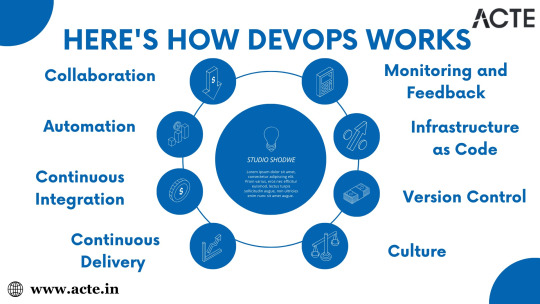
The Cultural Shift:
DevOps isn't just about tools and processes; it's also about fostering a cultural shift within an organization.
Shared Responsibility: DevOps promotes a culture of shared responsibility, where both development and operations teams take ownership of the entire software delivery process. This reduces blame-shifting and encourages problem-solving.
Accountability: DevOps encourages accountability for code quality, security, and performance. Team members are responsible for the outcomes of their work, from development to deployment.
Trust and Collaboration: Open communication and trust between teams are essential. DevOps encourages cross-functional teams to work together, breaking down traditional barriers.
DevOps is not just a trend but a transformative approach to software development and deployment. Its principles of collaboration, automation, and cultural transformation are reshaping the industry. ACTE Technologies, through its training and consulting services, plays a pivotal role in preparing professionals and organizations for success in the DevOps-driven world. Embracing DevOps and partnering with ACTE Technologies can lead to faster, more reliable software delivery and a competitive edge in today's dynamic tech landscape. Start your DevOps journey today and reap the benefits of this revolutionary approach.
18 notes
·
View notes
Text
Azure DevOps Training
Azure DevOps Training Programs

In today's rapidly evolving tech landscape, mastering Azure DevOps has become indispensable for organizations aiming to streamline their software development and delivery processes. As businesses increasingly migrate their operations to the cloud, the demand for skilled professionals proficient in Azure DevOps continues to soar. In this comprehensive guide, we'll delve into the significance of Azure DevOps training and explore the myriad benefits it offers to both individuals and enterprises.
Understanding Azure DevOps:
Before we delve into the realm of Azure DevOps training, let's first grasp the essence of Azure DevOps itself. Azure DevOps is a robust suite of tools offered by Microsoft Azure that facilitates collaboration, automation, and orchestration across the entire software development lifecycle. From planning and coding to building, testing, and deployment, Azure DevOps provides a unified platform for managing and executing diverse DevOps tasks seamlessly.
Why Azure DevOps Training Matters:
With Azure DevOps emerging as the cornerstone of modern DevOps practices, acquiring proficiency in this domain has become imperative for IT professionals seeking to stay ahead of the curve. Azure DevOps training equips individuals with the knowledge and skills necessary to leverage Microsoft Azure's suite of tools effectively. Whether you're a developer, IT administrator, or project manager, undergoing Azure DevOps training can significantly enhance your career prospects and empower you to drive innovation within your organization.
Key Components of Azure DevOps Training Programs:
Azure DevOps training programs are meticulously designed to cover a wide array of topics essential for mastering the intricacies of Azure DevOps. From basic concepts to advanced techniques, these programs encompass the following key components:
Azure DevOps Fundamentals: An in-depth introduction to Azure DevOps, including its core features, functionalities, and architecture.
Agile Methodologies: Understanding Agile principles and practices, and how they align with Azure DevOps for efficient project management and delivery.
Continuous Integration (CI): Learning to automate the process of integrating code changes into a shared repository, thereby enabling early detection of defects and ensuring software quality.
Continuous Deployment (CD): Exploring the principles of continuous deployment and mastering techniques for automating the deployment of applications to production environments.
Azure Pipelines: Harnessing the power of Azure Pipelines for building, testing, and deploying code across diverse platforms and environments.
Infrastructure as Code (IaC): Leveraging Infrastructure as Code principles to automate the provisioning and management of cloud resources using tools like Azure Resource Manager (ARM) templates.
Monitoring and Logging: Implementing robust monitoring and logging solutions to gain insights into application performance and troubleshoot issues effectively.
Security and Compliance: Understanding best practices for ensuring the security and compliance of Azure DevOps environments, including identity and access management, data protection, and regulatory compliance.
The Benefits of Azure DevOps Certification:
Obtaining Azure DevOps certification not only validates your expertise in Azure DevOps but also serves as a testament to your commitment to continuous learning and professional development. Azure DevOps certifications offered by Microsoft Azure are recognized globally and can open doors to exciting career opportunities in various domains, including cloud computing, software development, and DevOps engineering.
Conclusion:
In conclusion, Azure DevOps training is indispensable for IT professionals looking to enhance their skills and stay relevant in today's dynamic tech landscape. By undergoing comprehensive Azure DevOps training programs and obtaining relevant certifications, individuals can unlock a world of opportunities and propel their careers to new heights. Whether you're aiming to streamline your organization's software delivery processes or embark on a rewarding career journey, mastering Azure DevOps is undoubtedly a game-changer. So why wait? Start your Azure DevOps training journey today and pave the way for a brighter tomorrow.
5 notes
·
View notes
Text
Journey to Devops
The concept of “DevOps” has been gaining traction in the IT sector for a couple of years. It involves promoting teamwork and interaction, between software developers and IT operations groups to enhance the speed and reliability of software delivery. This strategy has become widely accepted as companies strive to provide software to meet customer needs and maintain an edge, in the industry. In this article we will explore the elements of becoming a DevOps Engineer.
Step 1: Get familiar with the basics of Software Development and IT Operations:
In order to pursue a career as a DevOps Engineer it is crucial to possess a grasp of software development and IT operations. Familiarity with programming languages like Python, Java, Ruby or PHP is essential. Additionally, having knowledge about operating systems, databases and networking is vital.
Step 2: Learn the principles of DevOps:
It is crucial to comprehend and apply the principles of DevOps. Automation, continuous integration, continuous deployment and continuous monitoring are aspects that need to be understood and implemented. It is vital to learn how these principles function and how to carry them out efficiently.
Step 3: Familiarize yourself with the DevOps toolchain:
Git: Git, a distributed version control system is extensively utilized by DevOps teams, for code repository management. It aids in monitoring code alterations facilitating collaboration, among team members and preserving a record of modifications made to the codebase.
Ansible: Ansible is an open source tool used for managing configurations deploying applications and automating tasks. It simplifies infrastructure management. Saves time when performing tasks.
Docker: Docker, on the other hand is a platform for containerization that allows DevOps engineers to bundle applications and dependencies into containers. This ensures consistency and compatibility across environments from development, to production.
Kubernetes: Kubernetes is an open-source container orchestration platform that helps manage and scale containers. It helps automate the deployment, scaling, and management of applications and micro-services.
Jenkins: Jenkins is an open-source automation server that helps automate the process of building, testing, and deploying software. It helps to automate repetitive tasks and improve the speed and efficiency of the software delivery process.
Nagios: Nagios is an open-source monitoring tool that helps us monitor the health and performance of our IT infrastructure. It also helps us to identify and resolve issues in real-time and ensure the high availability and reliability of IT systems as well.
Terraform: Terraform is an infrastructure as code (IAC) tool that helps manage and provision IT infrastructure. It helps us automate the process of provisioning and configuring IT resources and ensures consistency between development and production environments.
Step 4: Gain practical experience:
The best way to gain practical experience is by working on real projects and bootcamps. You can start by contributing to open-source projects or participating in coding challenges and hackathons. You can also attend workshops and online courses to improve your skills.
Step 5: Get certified:
Getting certified in DevOps can help you stand out from the crowd and showcase your expertise to various people. Some of the most popular certifications are:
Certified Kubernetes Administrator (CKA)
AWS Certified DevOps Engineer
Microsoft Certified: Azure DevOps Engineer Expert
AWS Certified Cloud Practitioner
Step 6: Build a strong professional network:
Networking is one of the most important parts of becoming a DevOps Engineer. You can join online communities, attend conferences, join webinars and connect with other professionals in the field. This will help you stay up-to-date with the latest developments and also help you find job opportunities and success.
Conclusion:
You can start your journey towards a successful career in DevOps. The most important thing is to be passionate about your work and continuously learn and improve your skills. With the right skills, experience, and network, you can achieve great success in this field and earn valuable experience.
2 notes
·
View notes
Text
AWS DevOps Careers: Navigating the Cloud-Infused Professional Landscape
In the rapidly evolving tech terrain, the confluence of AWS and DevOps has given rise to a dynamic realm, promising an array of career prospects. This all-encompassing guide unveils the diverse roles and responsibilities within AWS DevOps, offering insights into the multifaceted career avenues that await proficient individuals.
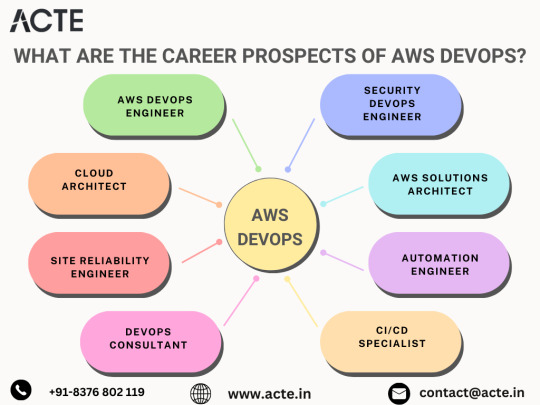
1. Crafting Cloud Solutions: The Role of an AWS DevOps Engineer
Overview: AWS DevOps Engineers serve as architects of automated software development, leveraging AWS cloud services.
Responsibilities: Dive into Infrastructure as Code (IaC), fine-tune AWS tools, and champion the principles of Continuous Integration/Continuous Deployment (CI/CD).
2. Architecting Scalable Cloud Solutions: The Realm of Cloud Architects
Overview: Cloud Architects design scalable and reliable cloud infrastructure on AWS, seamlessly aligning with DevOps principles.
Responsibilities: Collaborate to optimize AWS services, ensuring a resilient and scalable cloud environment.
3. Reliability in the Cloud: The Role of a Site Reliability Engineer (SRE)
Overview: SREs focus on ensuring system reliability, availability, and performance on AWS through vigilant monitoring and automation.
Responsibilities: Implement automation strategies, monitor AWS resources, and respond adeptly to incidents.
4. DevOps Consultancy: Guiding Organizations to DevOps Excellence
Overview: DevOps Consultants provide expertise in implementing DevOps practices, specializing in AWS services.
Responsibilities: Offer guidance on best practices, implement CI/CD pipelines, and optimize workflows using AWS tools.

5. Embedding Security into DevOps: The Role of a Security DevOps Engineer (DevSecOps)
Overview: DevSecOps Engineers integrate security practices into the AWS DevOps pipeline.
Responsibilities: Implement robust security measures, conduct risk assessments, and ensure compliance with security policies.
6. Solutions Architecture on AWS: Crafting Business-Aligned Solutions
Overview: AWS Solutions Architects design and implement solutions aligned with business requirements, utilizing AWS services.
Responsibilities: Collaborate across teams, grasp project intricacies, and architect solutions that optimize AWS resources.
7. Scripting the Future: The Role of an Automation Engineer in AWS
Overview: Automation Engineers script and automate processes within AWS DevOps.
Responsibilities: Script infrastructure deployment, automate testing processes, and lead AWS automation initiatives.
8. Streamlining Software Delivery: The Role of a CI/CD Specialist on AWS
Overview: CI/CD Specialists optimize and streamline the software delivery pipeline within the AWS environment.
Responsibilities: Configure and manage CI/CD tools, ensuring the efficient and reliable delivery of software.
Embarking on an AWS DevOps career journey presents professionals with a landscape rich in challenges and opportunities. Each role within AWS DevOps contributes to a fulfilling and dynamic career trajectory, promising innovation and significant contributions to the ever-evolving technological realm. Best of luck as you navigate the transformative path of AWS DevOps careers!
2 notes
·
View notes
Text
Going Over the Cloud: An Investigation into the Architecture of Cloud Solutions

Because the cloud offers unprecedented levels of size, flexibility, and accessibility, it has fundamentally altered the way we approach technology in the present digital era. As more and more businesses shift their infrastructure to the cloud, it is imperative that they understand the architecture of cloud solutions. Join me as we examine the core concepts, industry best practices, and transformative impacts on modern enterprises.
The Basics of Cloud Solution Architecture A well-designed architecture that balances dependability, performance, and cost-effectiveness is the foundation of any successful cloud deployment. Cloud solutions' architecture is made up of many different components, including networking, computing, storage, security, and scalability. By creating solutions that are tailored to the requirements of each workload, organizations can optimize return on investment and fully utilize the cloud.
Flexibility and Resilience in Design The flexibility of cloud computing to grow resources on-demand to meet varying workloads and guarantee flawless performance is one of its distinguishing characteristics. Cloud solution architecture create resilient systems that can endure failures and sustain uptime by utilizing fault-tolerant design principles, load balancing, and auto-scaling. Workloads can be distributed over several availability zones and regions to help enterprises increase fault tolerance and lessen the effect of outages.
Protection of Data in the Cloud and Security by Design
As data thefts become more common, security becomes a top priority in cloud solution architecture. Architects include identity management, access controls, encryption, and monitoring into their designs using a multi-layered security strategy. By adhering to industry standards and best practices, such as the shared responsibility model and compliance frameworks, organizations may safeguard confidential information and guarantee regulatory compliance in the cloud.
Using Professional Services to Increase Productivity Cloud service providers offer a variety of managed services that streamline operations and reduce the stress of maintaining infrastructure. These services allow firms to focus on innovation instead of infrastructure maintenance. They include server less computing, machine learning, databases, and analytics. With cloud-native applications, architects may reduce costs, increase time-to-market, and optimize performance by selecting the right mix of managed services.
Cost control and ongoing optimization Cost optimization is essential since inefficient resource use can quickly drive up costs. Architects monitor resource utilization, analyze cost trends, and identify opportunities for optimization with the aid of tools and techniques. Businesses can cut waste and maximize their cloud computing expenses by using spot instances, reserved instances, and cost allocation tags.
Acknowledging Automation and DevOps Important elements of cloud solution design include automation and DevOps concepts, which enable companies to develop software more rapidly, reliably, and efficiently. Architects create pipelines for continuous integration, delivery, and deployment, which expedites the software development process and allows for rapid iterations. By provisioning and managing infrastructure programmatically with Infrastructure as Code (IaC) and Configuration Management systems, teams may minimize human labor and guarantee consistency across environments.
Multiple-cloud and hybrid strategies In an increasingly interconnected world, many firms employ hybrid and multi-cloud strategies to leverage the benefits of many cloud providers in addition to on-premises infrastructure. Cloud solution architects have to design systems that seamlessly integrate several environments while ensuring interoperability, data consistency, and regulatory compliance. By implementing hybrid connection options like VPNs, Direct Connect, or Express Route, organizations may develop hybrid cloud deployments that include the best aspects of both public and on-premises data centers. Analytics and Data Management Modern organizations depend on data because it fosters innovation and informed decision-making. Thanks to the advanced data management and analytics solutions developed by cloud solution architects, organizations can effortlessly gather, store, process, and analyze large volumes of data. By leveraging cloud-native data services like data warehouses, data lakes, and real-time analytics platforms, organizations may gain a competitive advantage in their respective industries and extract valuable insights. Architects implement data governance frameworks and privacy-enhancing technologies to ensure adherence to data protection rules and safeguard sensitive information.
Computing Without a Server Server less computing, a significant shift in cloud architecture, frees organizations to focus on creating applications rather than maintaining infrastructure or managing servers. Cloud solution architects develop server less programs using event-driven architectures and Function-as-a-Service (FaaS) platforms such as AWS Lambda, Azure Functions, or Google Cloud Functions. By abstracting away the underlying infrastructure, server less architectures offer unparalleled scalability, cost-efficiency, and agility, empowering companies to innovate swiftly and change course without incurring additional costs.
Conclusion As we come to the close of our investigation into cloud solution architecture, it is evident that the cloud is more than just a platform for technology; it is a force for innovation and transformation. By embracing the ideas of scalability, resilience, and security, and efficiency, organizations can take advantage of new opportunities, drive business expansion, and preserve their competitive edge in today's rapidly evolving digital market. Thus, to ensure success, remember to leverage cloud solution architecture when developing a new cloud-native application or initiating a cloud migration.
1 note
·
View note
Text
From Flexibility to Security: Unraveling the AWS Advantage
In the ever-evolving landscape of cloud computing, Amazon Web Services (AWS) stands out as a trailblazer, offering a robust and versatile platform that has redefined the way businesses and individuals leverage computing resources. AWS Training in Bangalore further enhances the accessibility and proficiency of individuals and businesses in leveraging the full potential of this powerful cloud platform. With AWS training in Bangalore, professionals can gain the skills and knowledge needed to harness the capabilities of AWS for diverse applications and industries.
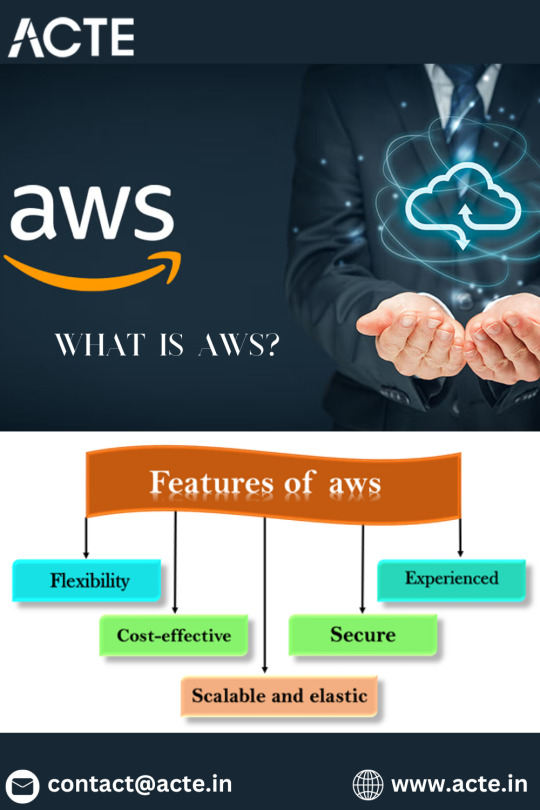
Let's take a closer look at the key aspects that make AWS a cornerstone in the world of cloud computing.
1. Cloud Computing Services for Every Need
At its core, AWS is a comprehensive cloud computing platform that provides a vast array of services. These services encompass Infrastructure as a Service (IaaS), Platform as a Service (PaaS), and Software as a Service (SaaS), offering users a flexible and scalable approach to computing.
2. Scalability and Flexibility
A defining feature of AWS is its scalability. Users have the ability to scale their resources up or down based on demand. This flexibility is particularly advantageous for businesses with varying workloads, allowing them to optimize costs while ensuring optimal performance.
3. Global Infrastructure for Enhanced Performance
AWS operates a global network of data centers known as Availability Zones, strategically located in regions around the world. This geographical diversity enables users to deploy applications and services close to end-users, enhancing performance, and ensuring high availability.
4. Emphasis on Security and Compliance
Security is a top priority for AWS. The platform offers robust security features, including data encryption, identity and access management, and compliance with various industry standards and regulations. This commitment to security instills confidence in users, especially those handling sensitive data.
5. Cost-Efficiency at Its Core
AWS follows a pay-as-you-go pricing model, allowing users to pay only for the resources they consume. This cost-efficient approach makes AWS accessible to startups, small businesses, and enterprises alike, eliminating the need for significant upfront investments.
6. Comprehensive Service Offerings
AWS boasts an extensive portfolio of services, covering computing, storage, databases, machine learning, analytics, IoT, security, and more. This diversity empowers users to build, deploy, and manage applications for virtually any purpose, making AWS a one-stop-shop for a wide range of computing needs.
7. Vibrant Ecosystem and Community
The AWS ecosystem is vibrant and dynamic, supported by a large community of users, developers, and partners. This ecosystem includes a marketplace for third-party applications and services, as well as a wealth of documentation, tutorials, and forums that foster collaboration and support.
8. Enterprise-Grade Reliability
The reliability of AWS is paramount, attracting the trust of many large enterprises, startups, and government organizations. Its redundant architecture and robust infrastructure contribute to high availability and fault tolerance, crucial for mission-critical applications.
9. Continuous Innovation
Innovation is ingrained in the AWS DNA. The platform consistently introduces new features and services to address evolving industry needs and technological advancements. Staying at the forefront of innovation ensures that AWS users have access to cutting-edge tools and capabilities.
10. Facilitating DevOps and Automation
AWS supports DevOps practices, empowering organizations to automate processes and streamline development workflows. This emphasis on automation contributes to faster and more efficient software delivery, aligning with modern development practices.

In conclusion, Amazon Web Services (AWS) stands as a powerhouse in the cloud computing arena. Its scalability, security features, and extensive service offerings make it a preferred choice for organizations seeking to harness the benefits of cloud technology. Whether you're a startup, a small business, or a large enterprise, AWS provides the tools and resources to propel your digital initiatives forward. As the cloud computing landscape continues to evolve, AWS remains a stalwart, driving innovation and empowering users to build and scale with confidence. To master the intricacies of AWS and unlock its full potential, individuals can benefit from enrolling in the Best AWS Training Institute. This training ensures that professionals gain the expertise needed to navigate the complexities of AWS, empowering them to contribute effectively to their organizations' digital transformation and success.
2 notes
·
View notes
Text
Your Journey Through the AWS Universe: From Amateur to Expert
In the ever-evolving digital landscape, cloud computing has emerged as a transformative force, reshaping the way businesses and individuals harness technology. At the forefront of this revolution stands Amazon Web Services (AWS), a comprehensive cloud platform offered by Amazon. AWS is a dynamic ecosystem that provides an extensive range of services, designed to meet the diverse needs of today's fast-paced world.

This guide is your key to unlocking the boundless potential of AWS. We'll embark on a journey through the AWS universe, exploring its multifaceted applications and gaining insights into why it has become an indispensable tool for organizations worldwide. Whether you're a seasoned IT professional or a newcomer to cloud computing, this comprehensive resource will illuminate the path to mastering AWS and leveraging its capabilities for innovation and growth. Join us as we clarify AWS and discover how it is reshaping the way we work, innovate, and succeed in the digital age.
Navigating the AWS Universe:
Hosting Websites and Web Applications: AWS provides a secure and scalable place for hosting websites and web applications. Services like Amazon EC2 and Amazon S3 empower businesses to deploy and manage their online presence with unwavering reliability and high performance.
Scalability: At the core of AWS lies its remarkable scalability. Organizations can seamlessly adjust their infrastructure according to the ebb and flow of workloads, ensuring optimal resource utilization in today's ever-changing business environment.
Data Storage and Backup: AWS offers a suite of robust data storage solutions, including the highly acclaimed Amazon S3 and Amazon EBS. These services cater to the diverse spectrum of data types, guaranteeing data security and perpetual availability.
Databases: AWS presents a panoply of database services such as Amazon RDS, DynamoDB, and Redshift, each tailored to meet specific data management requirements. Whether it's a relational database, a NoSQL database, or data warehousing, AWS offers a solution.
Content Delivery and CDN: Amazon CloudFront, AWS's content delivery network (CDN) service, ushers in global content distribution with minimal latency and blazing data transfer speeds. This ensures an impeccable user experience, irrespective of geographical location.
Machine Learning and AI: AWS boasts a rich repertoire of machine learning and AI services. Amazon SageMaker simplifies the development and deployment of machine learning models, while pre-built AI services cater to natural language processing, image analysis, and more.
Analytics: In the heart of AWS's offerings lies a robust analytics and business intelligence framework. Services like Amazon EMR enable the processing of vast datasets using popular frameworks like Hadoop and Spark, paving the way for data-driven decision-making.
IoT (Internet of Things): AWS IoT services provide the infrastructure for the seamless management and data processing of IoT devices, unlocking possibilities across industries.
Security and Identity: With an unwavering commitment to data security, AWS offers robust security features and identity management through AWS Identity and Access Management (IAM). Users wield precise control over access rights, ensuring data integrity.
DevOps and CI/CD: AWS simplifies DevOps practices with services like AWS CodePipeline and AWS CodeDeploy, automating software deployment pipelines and enhancing collaboration among development and operations teams.
Content Creation and Streaming: AWS Elemental Media Services facilitate the creation, packaging, and efficient global delivery of video content, empowering content creators to reach a global audience seamlessly.
Migration and Hybrid Cloud: For organizations seeking to migrate to the cloud or establish hybrid cloud environments, AWS provides a suite of tools and services to streamline the process, ensuring a smooth transition.
Cost Optimization: AWS's commitment to cost management and optimization is evident through tools like AWS Cost Explorer and AWS Trusted Advisor, which empower users to monitor and control their cloud spending effectively.
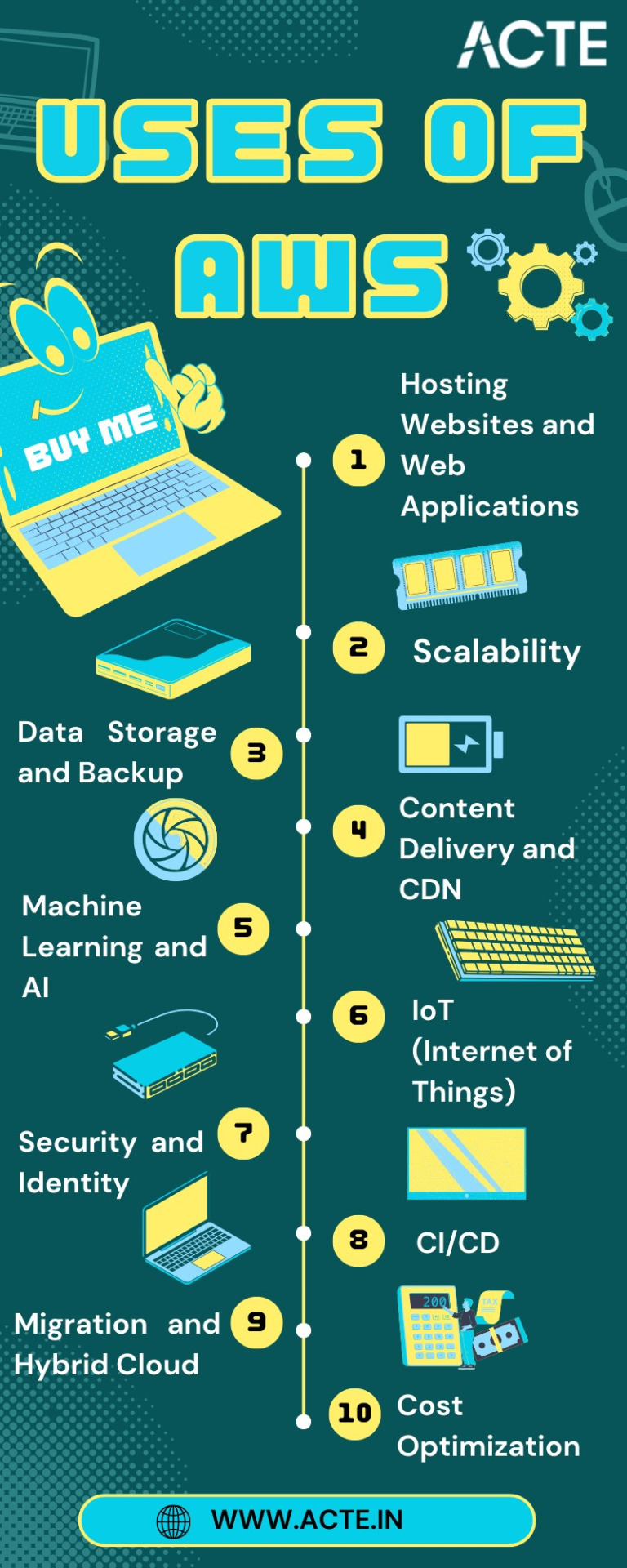
In this comprehensive journey through the expansive landscape of Amazon Web Services (AWS), we've embarked on a quest to unlock the power and potential of cloud computing. AWS, standing as a colossus in the realm of cloud platforms, has emerged as a transformative force that transcends traditional boundaries.
As we bring this odyssey to a close, one thing is abundantly clear: AWS is not merely a collection of services and technologies; it's a catalyst for innovation, a cornerstone of scalability, and a conduit for efficiency. It has revolutionized the way businesses operate, empowering them to scale dynamically, innovate relentlessly, and navigate the complexities of the digital era.
In a world where data reigns supreme and agility is a competitive advantage, AWS has become the bedrock upon which countless industries build their success stories. Its versatility, reliability, and ever-expanding suite of services continue to shape the future of technology and business.
Yet, AWS is not a solitary journey; it's a collaborative endeavor. Institutions like ACTE Technologies play an instrumental role in empowering individuals to master the AWS course. Through comprehensive training and education, learners are not merely equipped with knowledge; they are forged into skilled professionals ready to navigate the AWS universe with confidence.
As we contemplate the future, one thing is certain: AWS is not just a destination; it's an ongoing journey. It's a journey toward greater innovation, deeper insights, and boundless possibilities. AWS has not only transformed the way we work; it's redefining the very essence of what's possible in the digital age. So, whether you're a seasoned cloud expert or a newcomer to the cloud, remember that AWS is not just a tool; it's a gateway to a future where technology knows no bounds, and success knows no limits.
6 notes
·
View notes
Text
Full Stack Development: Using DevOps and Agile Practices for Success
In today’s fast-paced and highly competitive tech industry, the demand for Full Stack Developers is steadily on the rise. These versatile professionals possess a unique blend of skills that enable them to handle both the front-end and back-end aspects of software development. However, to excel in this role and meet the ever-evolving demands of modern software development, Full Stack Developers are increasingly turning to DevOps and Agile practices. In this comprehensive guide, we will explore how the combination of Full Stack Development with DevOps and Agile methodologies can lead to unparalleled success in the world of software development.
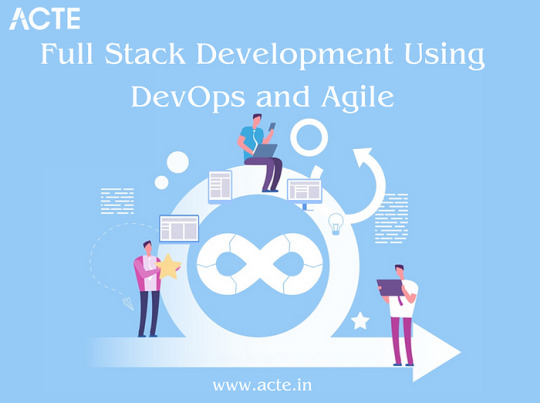
Full Stack Development: A Brief Overview
Full Stack Development refers to the practice of working on all aspects of a software application, from the user interface (UI) and user experience (UX) on the front end to server-side scripting, databases, and infrastructure on the back end. It requires a broad skill set and the ability to handle various technologies and programming languages.
The Significance of DevOps and Agile Practices
The environment for software development has changed significantly in recent years. The adoption of DevOps and Agile practices has become a cornerstone of modern software development. DevOps focuses on automating and streamlining the development and deployment processes, while Agile methodologies promote collaboration, flexibility, and iterative development. Together, they offer a powerful approach to software development that enhances efficiency, quality, and project success. In this blog, we will delve into the following key areas:
Understanding Full Stack Development
Defining Full Stack Development
We will start by defining Full Stack Development and elucidating its pivotal role in creating end-to-end solutions. Full Stack Developers are akin to the Swiss Army knives of the development world, capable of handling every aspect of a project.
Key Responsibilities of a Full Stack Developer
We will explore the multifaceted responsibilities of Full Stack Developers, from designing user interfaces to managing databases and everything in between. Understanding these responsibilities is crucial to grasping the challenges they face.
DevOps’s Importance in Full Stack Development
Unpacking DevOps
A collection of principles known as DevOps aims to eliminate the divide between development and operations teams. We will delve into what DevOps entails and why it matters in Full Stack Development. The benefits of embracing DevOps principles will also be discussed.
Agile Methodologies in Full Stack Development
Introducing Agile Methodologies
Agile methodologies like Scrum and Kanban have gained immense popularity due to their effectiveness in fostering collaboration and adaptability. We will introduce these methodologies and explain how they enhance project management and teamwork in Full Stack Development.
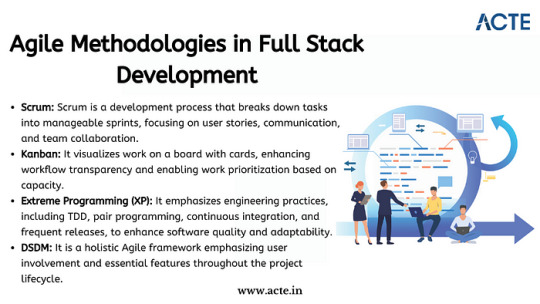
Synergy Between DevOps and Agile
The Power of Collaboration
We will highlight how DevOps and Agile practices complement each other, creating a synergy that streamlines the entire development process. By aligning development, testing, and deployment, this synergy results in faster delivery and higher-quality software.
Tools and Technologies for DevOps in Full Stack Development
Essential DevOps Tools
DevOps relies on a suite of tools and technologies, such as Jenkins, Docker, and Kubernetes, to automate and manage various aspects of the development pipeline. We will provide an overview of these tools and explain how they can be harnessed in Full Stack Development projects.

Implementing Agile in Full Stack Projects
Agile Implementation Strategies
We will delve into practical strategies for implementing Agile methodologies in Full Stack projects. Topics will include sprint planning, backlog management, and conducting effective stand-up meetings.
Best Practices for Agile Integration
We will share best practices for incorporating Agile principles into Full Stack Development, ensuring that projects are nimble, adaptable, and responsive to changing requirements.
Learning Resources and Real-World Examples
To gain a deeper understanding, ACTE Institute present case studies and real-world examples of successful Full Stack Development projects that leveraged DevOps and Agile practices. These stories will offer valuable insights into best practices and lessons learned. Consider enrolling in accredited full stack developer training course to increase your full stack proficiency.
Challenges and Solutions
Addressing Common Challenges
No journey is without its obstacles, and Full Stack Developers using DevOps and Agile practices may encounter challenges. We will identify these common roadblocks and provide practical solutions and tips for overcoming them.
Benefits and Outcomes
The Fruits of Collaboration
In this section, we will discuss the tangible benefits and outcomes of integrating DevOps and Agile practices in Full Stack projects. Faster development cycles, improved product quality, and enhanced customer satisfaction are among the rewards.
In conclusion, this blog has explored the dynamic world of Full Stack Development and the pivotal role that DevOps and Agile practices play in achieving success in this field. Full Stack Developers are at the forefront of innovation, and by embracing these methodologies, they can enhance their efficiency, drive project success, and stay ahead in the ever-evolving tech landscape. We emphasize the importance of continuous learning and adaptation, as the tech industry continually evolves. DevOps and Agile practices provide a foundation for success, and we encourage readers to explore further resources, courses, and communities to foster their growth as Full Stack Developers. By doing so, they can contribute to the development of cutting-edge solutions and make a lasting impact in the world of software development.
#web development#full stack developer#devops#agile#education#information#technology#full stack web development#innovation
2 notes
·
View notes
Text
Azure’s Evolution: What Every IT Pro Should Know About Microsoft’s Cloud
IT professionals need to keep ahead of the curve in the ever changing world of technology today. The cloud has become an integral part of modern IT infrastructure, and one of the leading players in this domain is Microsoft Azure. Azure’s evolution over the years has been nothing short of remarkable, making it essential for IT pros to understand its journey and keep pace with its innovations. In this blog, we’ll take you on a journey through Azure’s transformation, exploring its history, service portfolio, global reach, security measures, and much more. By the end of this article, you’ll have a comprehensive understanding of what every IT pro should know about Microsoft’s cloud platform.
Historical Overview
Azure’s Humble Beginnings
Microsoft Azure was officially launched in February 2010 as ��Windows Azure.” It began as a platform-as-a-service (PaaS) offering primarily focused on providing Windows-based cloud services.
The Azure Branding Shift
In 2014, Microsoft rebranded Windows Azure to Microsoft Azure to reflect its broader support for various operating systems, programming languages, and frameworks. This rebranding marked a significant shift in Azure’s identity and capabilities.
Key Milestones
Over the years, Azure has achieved numerous milestones, including the introduction of Azure Virtual Machines, Azure App Service, and the Azure Marketplace. These milestones have expanded its capabilities and made it a go-to choice for businesses of all sizes.
Expanding Service Portfolio
Azure’s service portfolio has grown exponentially since its inception. Today, it offers a vast array of services catering to diverse needs:
Compute Services: Azure provides a range of options, from virtual machines (VMs) to serverless computing with Azure Functions.
Data Services: Azure offers data storage solutions like Azure SQL Database, Cosmos DB, and Azure Data Lake Storage.
AI and Machine Learning: With Azure Machine Learning and Cognitive Services, IT pros can harness the power of AI for their applications.
IoT Solutions: Azure IoT Hub and IoT Central simplify the development and management of IoT solutions.
Azure Regions and Global Reach
Azure boasts an extensive network of data centers spread across the globe. This global presence offers several advantages:
Scalability: IT pros can easily scale their applications by deploying resources in multiple regions.
Redundancy: Azure’s global datacenter presence ensures high availability and data redundancy.
Data Sovereignty: Choosing the right Azure region is crucial for data compliance and sovereignty.
Integration and Hybrid Solutions
Azure’s integration capabilities are a boon for businesses with hybrid cloud needs. Azure Arc, for instance, allows you to manage on-premises, multi-cloud, and edge environments through a unified interface. Azure’s compatibility with other cloud providers simplifies multi-cloud management.
Security and Compliance
Azure has made significant strides in security and compliance. It offers features like Azure Security Center, Azure Active Directory, and extensive compliance certifications. IT pros can leverage these tools to meet stringent security and regulatory requirements.
Azure Marketplace and Third-Party Offerings
Azure Marketplace is a treasure trove of third-party solutions that complement Azure services. IT pros can explore a wide range of offerings, from monitoring tools to cybersecurity solutions, to enhance their Azure deployments.
Azure DevOps and Automation
Automation is key to efficiently managing Azure resources. Azure DevOps services and tools facilitate continuous integration and continuous delivery (CI/CD), ensuring faster and more reliable application deployments.
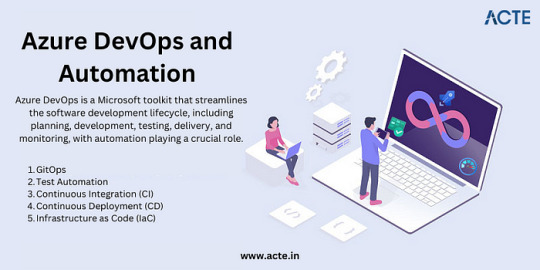
Monitoring and Management
Azure offers robust monitoring and management tools to help IT pros optimize resource usage, troubleshoot issues, and gain insights into their Azure deployments. Best practices for resource management can help reduce costs and improve performance.
Future Trends and Innovations
As the technology landscape continues to evolve, Azure remains at the forefront of innovation. Keep an eye on trends like edge computing and quantum computing, as Azure is likely to play a significant role in these domains.
Training and Certification
To excel in your IT career, consider pursuing Azure certifications. ACTE Institute offers a range of certifications, such as the Microsoft Azure course to validate your expertise in Azure technologies.
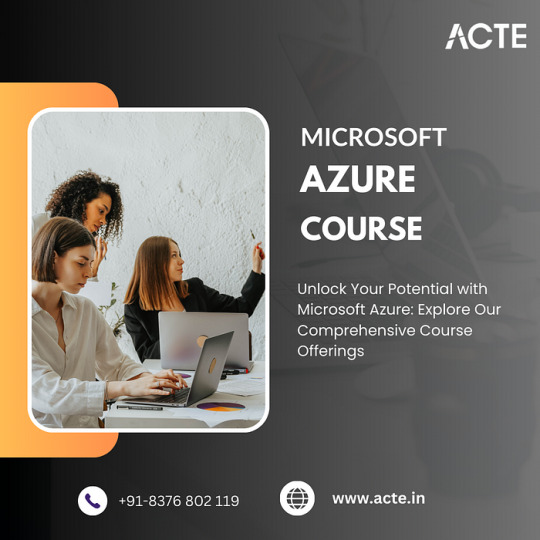
In conclusion, Azure’s evolution is a testament to Microsoft’s commitment to cloud innovation. As an IT professional, understanding Azure’s history, service offerings, global reach, security measures, and future trends is paramount. Azure’s versatility and comprehensive toolset make it a top choice for organizations worldwide. By staying informed and adapting to Azure’s evolving landscape, IT pros can remain at the forefront of cloud technology, delivering value to their organizations and clients in an ever-changing digital world. Embrace Azure’s evolution, and empower yourself for a successful future in the cloud.
#microsoft azure#tech#education#cloud services#azure devops#information technology#automation#innovation
2 notes
·
View notes
Text
aws online training in ameerpet

Amazon Web Services (AWS) is a widely used cloud computing platform that provides a variety of services and tools for building, deploying, and managing applications in the cloud. As the demand for skilled AWS professionals continues to grow, APEC IT Training offers comprehensive AWS training programs that are designed to teach participants the skills necessary to become proficient AWS developers and administrators.The AWS training program offered by APEC IT Training covers a wide range of topics, including AWS core services, security and compliance, migration, and automation. Participants are also introduced to more advanced topics such as DevOps, machine learning, and big data.
The course usually starts with the basics of AWS, including AWS Identity and Access Management (IAM), Elastic Compute Cloud (EC2), and Simple Storage Service (S3). Participants then move on to more advanced topics such as building scalable and fault-tolerant applications using AWS services such as Elastic Load Balancing, Auto Scaling, and Route 53.The training program also covers best practices for securing and complying with AWS services, migrating applications to AWS, and automating infrastructure using AWS CloudFormation and AWS CodePipeline.
visit: http://www.apectraining.com/aws/
2 notes
·
View notes